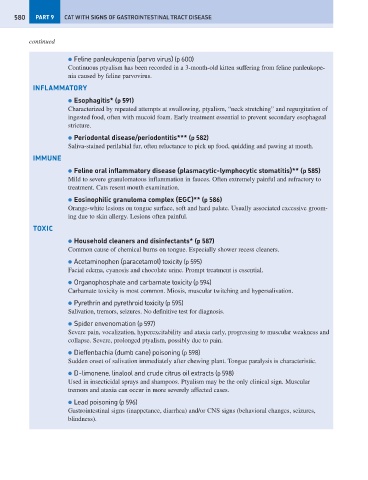Page 588 - Problem-Based Feline Medicine
P. 588
580 PART 9 CAT WITH SIGNS OF GASTROINTESTINAL TRACT DISEASE
continued
● Feline panleukopenia (parvo virus) (p 600)
Continuous ptyalism has been recorded in a 3-month-old kitten suffering from feline panleukope-
nia caused by feline parvovirus.
INFLAMMATORY
● Esophagitis* (p 591)
Characterized by repeated attempts at swallowing, ptyalism, “neck stretching” and regurgitation of
ingested food, often with mucoid foam. Early treatment essential to prevent secondary esophageal
stricture.
● Periodontal disease/periodontitis*** (p 582)
Saliva-stained perilabial fur, often reluctance to pick up food, quidding and pawing at mouth.
IMMUNE
● Feline oral inflammatory disease (plasmacytic-lymphocytic stomatitis)** (p 585)
Mild to severe granulomatous inflammation in fauces. Often extremely painful and refractory to
treatment. Cats resent mouth examination.
● Eosinophilic granuloma complex (EGC)** (p 586)
Orange-white lesions on tongue surface, soft and hard palate. Usually associated excessive groom-
ing due to skin allergy. Lesions often painful.
TOXIC
● Household cleaners and disinfectants* (p 587)
Common cause of chemical burns on tongue. Especially shower recess cleaners.
● Acetaminophen (paracetamol) toxicity (p 595)
Facial edema, cyanosis and chocolate urine. Prompt treatment is essential.
● Organophosphate and carbamate toxicity (p 594)
Carbamate toxicity is most common. Miosis, muscular twitching and hypersalivation.
● Pyrethrin and pyrethroid toxicity (p 595)
Salivation, tremors, seizures. No definitive test for diagnosis.
● Spider envenomation (p 597)
Severe pain, vocalization, hyperexcitability and ataxia early, progressing to muscular weakness and
collapse. Severe, prolonged ptyalism, possibly due to pain.
● Dieffenbachia (dumb cane) poisoning (p 598)
Sudden onset of salivation immediately after chewing plant. Tongue paralysis is characteristic.
● D-limonene, linalool and crude citrus oil extracts (p 598)
Used in insecticidal sprays and shampoos. Ptyalism may be the only clinical sign. Muscular
tremors and ataxia can occur in more severely affected cases.
● Lead poisoning (p 596)
Gastrointestinal signs (inappetance, diarrhea) and/or CNS signs (behavioral changes, seizures,
blindness).

